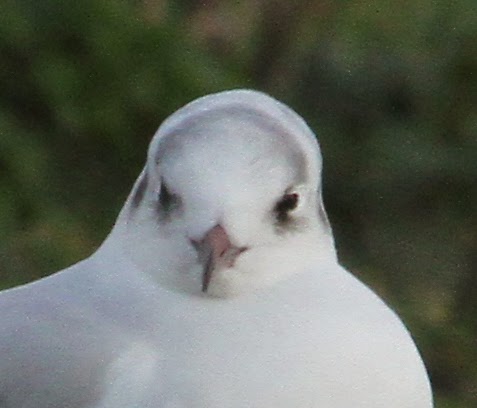Head patterns
Head patterns of adults are quite variable over the winter. Here we are getting the double headphones pattern.
Same bird, head turned partly towards us with both headphones still visible.
This is the same bird again, this time looking more directly in our direction. The first headphone is quite clear, the second is now on the reverse slope of the skull, except for both its lower ends.
The beak colour here is as in Ohlsen and Larsson, going towards the "concolorous maroon" of the breeding season as discussed below.
It is worth remembering that the moult into breeding plumage is only partial - relating to head and body only. The bird has to rely on the wing and tail feathers formed the previous summer for its successful performance during the breeding season.
"Those individuals who moult their hood early apparently do so every year. What is interesting though is that their moult takes place over a much longer period of time than for those individuals who acquire their full hood during the regular moult stage. Those who have a normal moult do so very quickly, up to 10 – 15% a day. This means that a full hood can be acquired in around a week. The individuals that I have seen with early head moult (see examples below) took weeks before their hood was anywhere near completion." from the excellent "Gulls to the horizon" blog.
Beak colours
The beak colour seems to be generally orange in younger birds, ranging from yellow-orange to a more reddish-orange, and always with something of a dark tip (see non-adults page). In adults the beak colours seem to vary, being a bright to moderate red in late summer through to mid-winter, and then darkening to a dark blood red (maroon) as breeding approaches, often getting as dark as the dark tip of the bill, which itself slightly lightens until the beak can be described as "concolorous maroon". However in the mid-autumn it is often really quite a bright red, perhaps much more highly coloured than the winter mid-red. This could admittedly be an effect of higher light intensities.
This is a bird in mid-autumn seen at Barden in late October 2013, showing the moderately bright red colour to the bill:
This is a bird seen near Saint George in January 2014, and you can see how the tip is getting browner from the original black.
Weblinks for Black-headed Gulls
http://bhgullsni.blogspot.co.uk/
http://guernseygulls.blogspot.co.uk/
http://www.ridibundus.gull-research.org/01cymay.html
http://gullstothehorizon.wordpress.com/2013/01/05/the-p9-conondrum/





No comments:
Post a Comment